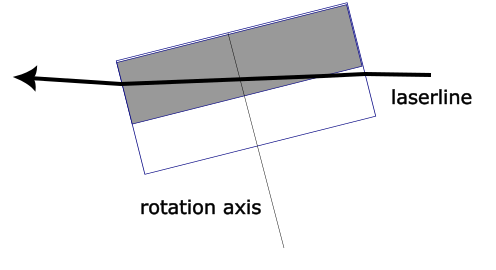A disadvantage of laser prism scanning is that the scanlines are shorter than in reflective polygon or galvo scanning. It is the main reason it did not attract more attention from companies such as Formlabs or Envisiontec. They took note but could not envision it in say form3L.
I reported to a lot of people that this is impossible to fix but might have been wrong. I did not consider the following configurations. It might be fixed if the prism is configured so that the incoming rays and outgoing rays are refracted through different parts of the prism. This allows one to tune the properties specifically for either incoming or outgoing rays.
This can be achieved by tilting the prism and not hitting at 90 degrees of the rotation angle or adding a wedge to the prism so the light is directed upwards and exits at a different height.
In the figure below, the side view of a prism can be seen. The rotation axis is not at 90 degrees with the incoming laser. The axis is denoted with rotation axis. The laser propagates from right to left and is denoted with laserline. The prism has a high and low area, illustrated as grey and white in the figure. In reality these areas can have the same refractive index and material. They can be indistinguishable. While refracting the laserlight crosses these areas. As a result the light enters and exits at a different height in the coordinate frame of the prism (not figure). As a result you can alter the gray prism in either material or shape of the surface, so it is optimal for outgoing rays given your application. This was not possible prior as the rotation axis was at a 90 degrees angle. Changes would also effect incoming rays. Now, the laser will never enter at the gray area if it rotates but always at the white. Earlier it exited at the same height..

Long story short this gives you degrees of freedom.
You could now tune the refractive index or change the shape of the prism to concave, convex, aspherical for the gray or white part and this would only effect the incoming or outgoing rays.
This most likely allows you, among others to extend the laser scanline which is now around 8-11 mm.
I am 100 percent sure, I did not include this in my earlier analysis. Still, I am often wrong so next step is probably to add a simulation.
Instead of tilting the prism you could also hit it at 90 degrees to the rotational direction and fix it with a wedge on the lower side (white area of the prism). It could then be directed upwards to the gray area, or top plane.
I can imagine more weird applications. But will focus on the longer scanline....
 Hexastorm
Hexastorm
Discussions
Become a Hackaday.io Member
Create an account to leave a comment. Already have an account? Log In.